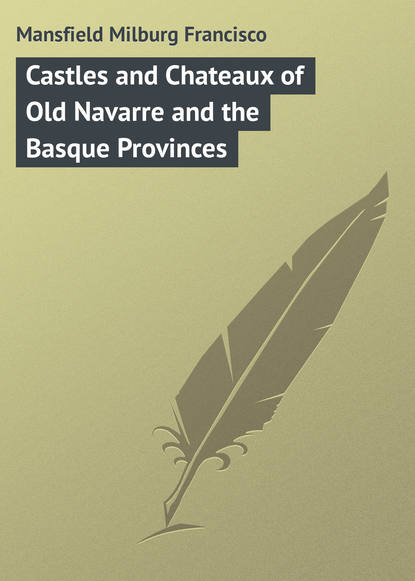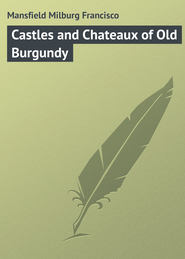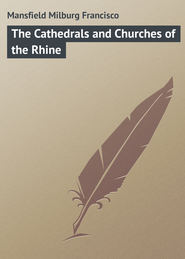По всем вопросам обращайтесь на: info@litportal.ru
(©) 2003-2024.
✖
Castles and Chateaux of Old Navarre and the Basque Provinces
Настройки чтения
Размер шрифта
Высота строк
Поля
Close by the Cap Cerbère, where French and Spanish territory join, is the little town and pass of Banyuls. This Col de Banyuls was, in 1793, the witness of a supreme act of patriotism. The Spaniards were biding their time to invade France via Roussillon, and made overtures to the people of the little village of Banyuls – famous to-day for its vins de liqueur and not much else, but at that time numbering less than a thousand souls – to join them and make the road easy. The procureur du roi replied simply: “Les habitants de Banyuls étant français devaient tous mourir pour l’honneur et l’indépendance de la France.”
Three thousand Spaniards thereupon attacked the entire forces of the little commune – men, women and children – but finding their efforts futile were forced to retire. This ended the “Battle of Banyuls,” one of the “little wars” that historians have usually neglected, or overlooked, in favour of something more spectacular.
On the old “Route Royale” from Paris to Barcelona, via Perpignan, are two chefs-d’œuvre of the mediæval bridge-builder, made before the days of steel rails and wire ropes and all their attendant ugliness. These are the Pont de Perpignan over the Basse, and the Pont de Céret on the Tech, each of them spanning the stream by one single, graceful arch. The latter dates from 1336, and it is doubtful if the modern stone-mason could do his work as well as he who was responsible for this architectural treasure.
One finds a bit of superstitious ignorance once and again, even in enlightened France of to-day. It was not far from here, on the road to the Col de Banyuls, that we were asked by a peasant from what country we came. He was told by way of a joke that we were Chinese. “Est-ce loin?” he asked. “Deux cents lieues!” “Diable! c’est une bonne distance!” One suspects that he knew more than he was given credit for, and perhaps it was he that was doing the joking, for he said by way of parting: “Ma foi, c’est bien triste d’être si loin de votre mère.”
What a little land of contrasts the region of the Pyrenees is! It is all things to all men. From the low-lying valleys and sea-coast plains, as one ascends into the upper regions, it is as if one went at once into another country. Certainly no greater contrast is marked in all France than that between the Hautes-Pyrénées and the Landes for instance.
The Hautes-Pyrénées of to-day was formerly made up of Bigorre, Armagnac and the extreme southerly portion of Gascogne. Cæsar called the people Tarbelli, Bigerriones and Flussates, and Visigoths, Franks and Gascons prevailed over their destinies in turn.
In the early feudal epoch Bigorre, “the country of the four valleys,” had its own counts, but was united with Béarn in 1252, becoming a part of the patrimony which Henri Quatre brought ultimately to the crown of France.
Antiquities before the middle ages are rare in these parts, in spite of the memories remaining from Roman times. Perhaps the greatest of these are the baths and springs at Cauterets, one of them being known as the Bains des Espagnoles and the other as the Bains de Cesar. These unquestionably were developed in Roman times.
The chief architectural glory of the region is the ancient city of St. Bertrand, the capital of Comminges, the ancient Lugdunum Convenarum of Strabon and Pliny. Its fortifications and its remarkable cathedral place it in the ranks with Carcassonne, Aigues-Mortes and Béziers.
The manners and customs of the Bigordans of the towns (not to be confounded with the Bigoudens of Brittany) have succumbed somewhat to the importation of outside ideas by the masses who throng their baths and springs, but nevertheless their main characteristics stand out plainly.
Quite different from the Béarnais are the Bigordans, and, somewhat uncharitably, the latter have a proverb which given in their own tongue is as follows: – “Béarnès faus et courtès.” Neighbourly jealousy accounts for this. The Béarnais are morose, steady and commercial, the Bigordans lively, bright and active, and their sociability is famed afar.
In the open country throughout the Pyrenees, there are three classes of inhabitants, those of the mountains and high valleys, those of the slopes, and those of the plains. The first are hard-working and active, but often ignorant and superstitious; the second are more gay, less frugal and better livers than the mountaineers; and those of the plains are often downright lazy and indolent. The mendicant race, of which old writers told, has apparently disappeared. There are practically no beggars in France except gypsies, and there is no mistaking a gypsy for any other species.
In general one can say that the inhabitants of the high Pyrenees are a simple, good and generous people, and far less given to excess than many others of the heterogeneous mass which make up the population of modern France.
Simple and commodious and made of the wool of the country are the general characteristics of the costumes of these parts, as indeed they are of most mountain regions. But the distinctive feature, with the men as with the women, is the topknot coiffure. In the plains, the men wear the pancake-like béret, and in the high valleys a sort of a woollen bonnet – something like a Phrygian cap. With the women it is a sort of a hood of red woollen stuff, black-bordered and exceedingly picturesque. “C’est un joli cadre pour le visage d’une jolie femme,” said a fat commercial traveller, with an eye for pretty women, whom the writer met at a Tarbes table d’hôte.
A writer of another century, presumably untravelled, in describing the folk of the Pyrenees remarked: “The Highlanders of the Pyrenees put one in mind of Scotland; they have round, flat caps and loose breeches.” Never mind the breeches, but the béret of the Basque is no more like the tam-o’-shanter of the Scot than is an anchovy like a herring.
An English traveller once remarked on the peculiar manner of transport in these parts in emphatic fashion. “With more sense than John Bull, the Pyrenean carter knows how to build and load his wagon to the best advantage,” he said. He referred to the great carts for transporting wine casks and barrels, built with the hind wheels much higher than the front ones. It’s a simple mechanical exposition of the principle that a wagon so built goes up-hill much easier.
Here in the Hautes-Pyrénées they speak the speech of Languedoc, with variations, idioms and bizarre interpolations, which may be Spanish, but sound like Arabic. At any rate it’s a beautiful, lisping patois, not at all like the speech of Paris, “twanged through the nose,” as the men of the Midi said of it when they went up to the capital in Revolutionary times “to help capture the king’s castle.”
The great literary light of the region was Despourrins, a poet of the eighteenth century, whose verses have found a permanent place in French literature, and whose rhymes were chanted as were those of the troubadours of centuries before.
To just how great an extent the patois differs from the French tongue the following verse of Despourrins will show: —
“Aci, debat aqueste peyre,
Repaüse lou plus gran de touts lou médecis,
Qui de poü d’està chens besis,
En a remplit lou cimetyre.
“Ici, sous cette pierre,
Repose le plus grand de tous les médicins,
Qui de peur d’être sans voisins
En a rempli le cimetière.”
A humourist also was this great poet!
Throughout the Pyrenean provinces, and along the shores of the Mediterranean, from Catalonia to the Bouches-du-Rhône are found the Gitanos, or the French Gypsies, who do not differ greatly from others of their tribe wherever found. This perhaps is accounted for by the fact that the shrines of their patron saint – Sara, the servant of the “Three Maries” exiled from Judea, and who settled at Les Saintes Maries-de-la-Mer – was located near the mouth of the Rhône. This same shrine is a place of pilgrimage for the gypsies of all the world, and on the twenty-fourth of May one may see sights here such as can be equalled nowhere else. Not many travellers’ itineraries have ever included a visit to this humble and lonesome little fishing village of the Bouches-du-Rhône, judging from the infrequency with which one meets written accounts.
Gypsy bands are numerous all through the Départements of the south of France, especially in Hérault and the Pyrénées-Orientales. Like most of their kind they are usually horse-traders, and perhaps horse-stealers, for their ideas of honesty and probity are not those of other men. They sometimes practise as sort of quack horse-doctors and horse and dog clippers, etc., and the women either make baskets, or, more frequently, simply beg, or “tire les cartes” and tell fortunes. They sing and dance and do many other things honest and dishonest to make a livelihood. Their world’s belongings are few and their wants are not great. For the most part their possessions consist only of their personal belongings, a horse, a donkey or a mule, their caravan, or roulotte, and a gold or silver chain or two, ear-rings in their ears, and a knife – of course a knife, for the vagabond gypsy doesn’t fight with fire-arms.
The further one goes into the French valleys of the Pyrenees the more one sees the real Gitanos of Spain, or at least of Spanish ancestry. Like all gypsy folk, they have no fixed abode, but roam and roam and roam, though never far away from their accustomed haunts. They multiply, but are seldom cross-bred out of their race.
It’s an idyllic life that the Gitano and the Romany-Chiel leads, or at least the poet would have us think so.
“Upon the road to Romany
It’s stay, friend, stay!
There’s lots o’ love and lots o’ time
To linger on the way;
Poppies for the twilight,
Roses for the noon,
It’s happy goes as lucky goes
To Romany in June.”
But as the Frenchman puts it, “look to the other side of the coin.”
Brigandage is the original profession of the gypsy, though to-day the only stealing which they do is done stealthily, and not in the plain hold-up fashion. They profess a profound regard for the Catholic religion, but they practise other rites in secret, and form what one versed in French Catholicism would call a “culte particulière.” It is known that they baptize their newly-born children as often as possible– of course each time in a different place – in order that they may solicit alms in each case. Down-right begging is forbidden in France, but for such a purpose the law is lenient.
They are gross feeders, the Gitanos, and a fowl “a little high” has no terrors for them; they have even been known to eat sea-gulls, which no white man has ever had the temerity to taste. It has been said that they will eat cats and dogs and even rats, but this is doubtless another version of the Chinese fable. At any rate a mere heating of their viands in a saucepan – not by any stretch of the imagination can it be called cooking – is enough for them, and what their dishes lack in cooking is made up by liberal additions of salt, pepper, piment (which is tobacco or something like it), and saffron.
As to type, the French Gitanos are of that olive-brown complexion, with the glossy black hair, usually associated with the stage gypsy, rather small in stature, but well set up, strong and robust, fine eyes and features and, with respect to the young women and girls (who marry young), often of an astonishing beauty. In the course of a very few years the beauty of the women pales considerably, owing, no doubt, to their hard life, but among the men their fine physique and lively emotional features endure until well past the half-century.
The gypsies are supposedly a joyful, amiable race; sometimes they are and sometimes they are not; but looking at them all round it is not difficult to apply the verses of Béranger, beginning:
“Sorciers, bateleurs ou filous
Reste immonde
D’un ancien monde
Gais Bohémiens, d’où venez-vous.”
One other class of residents in the Pyrenees must be mentioned here, and that is the family of Ursus and their descendants.
The bears of the Pyrenees are of two sorts; the dignified Ours des Pyrénées is a versatile and accomplished creature. Sometimes he is a carnivorous beast, and sometimes he is a vegetarian pure and simple – one of the kind which will not even eat eggs. The latter species is more mischievous than his terrible brother, for he forages stealthily in the night and eats wheat, buckwheat, maize, and any other breakfast-food, prepared or semi-prepared, he finds handy.
CHAPTER V
ROUSSILLON AND THE CATALANS
ROUSSILLON is a curious province. “Roussillon is a bow with two strings,” say the inhabitants. The workers in the vineyards of other days are becoming fishermen, and the fishermen are becoming vineyard workers. The arts of Neptune and the wiles of Bacchus have however conspired to give a prosperity to Roussillon which many more celebrated provinces lack.
The Roussillon of other days, a feudal power in its time, with its counts and nobles, has become but a Département of latter-day France. The first historical epochs of Roussillon are but obscurely outlined, but they began when Hannibal freed the Pyrenees in 536, and in time the Romans became masters here, as elsewhere in Gaul.
Then there came three hundred years of Visigoth rule, which brought the Saracens, and, in 760, Pepin claimed Roussillon for France. Then began the domination of the counts. First they were but delegates of the king, but in time they usurped royal authority and became rulers in their own right.
Roussillon had its own particular counts, but in a way they bowed down to the king of Aragon, though indeed the kings of France up to Louis IX considered themselves suzerains. By the Treaty of Corbeil Louis IX renounced this fief in 1258 to his brother king of Aragon. At the death of James I of Aragon his states were divided among his children, and Roussillon came to the kings of Majorca. Wars within and without now caused an era of bloodshed. Jean II, attacked by the men of Navarre and of Catalonia, demanded aid of Louis XI, who sent seven hundred lances and men, and three hundred thousand gold crown pieces, which latter the men of Roussillon were obliged to repay when the war was over. Jean II, Comte de Roussillon, hedged and demanded delay, and in due course was obliged to pawn his countship as security. This the Roussillonnais resented and revolt followed, when Louis XI without more ado went up against Perpignan and besieged it on two occasions before he could collect the sum total of his bill.
Charles VIII, returning from his Italian travels, in a generous frame of mind, gave back the province to the king of Aragon without demanding anything in return. Ferdinand of Aragon became in time king of Spain, by his marriage with Isabella, and Roussillon came again directly under Spanish domination.











